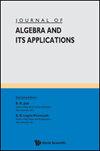The set of representatives and explicit factorization of xn − 1 over finite fields
IF 0.6
3区 数学
Q3 MATHEMATICS
引用次数: 0
Abstract
Let be a positive integer and let be a finite field with elements, where is a prime power and . In this paper, we give the explicit factorization of over and count the number of its irreducible factors for the following conditions: are odd and . First, we present a method to obtain the set of all representatives of -cyclotomic cosets modulo , where . This set of representatives is then used to find the irreducible factors of and the cyclotomic polynomial over . The form of irreducible factors of is characterized such that the coefficients of these irreducible factors are followed by second-order linear recurring sequences.
有限域上 xn - 1 的代表集和显因式分解
设 n 为正整数,𝔽q 为有 q 个元素的有限域,其中 q 为素数幂,且 gcd(n,q)=1 。在本文中,我们给出了 xn-1 在𝔽q 上的显式因式分解,并计算了在 n,q 为奇数且 rad(n)|(q2+1) 条件下的不可还原因式的个数。首先,我们提出了一种方法来获得 q-Cyclotomic cosets modulo m 的所有代表集,其中 m=gcd(n,q2+1) 。然后,利用这个代表集找出 xn-1 的不可还原因数和在𝔽q 上的循环多项式 Φn(x)。xn-1 不可还原因子的形式特征是,这些不可还原因子的系数由二阶线性循环序列跟随。
本文章由计算机程序翻译,如有差异,请以英文原文为准。
求助全文
约1分钟内获得全文
求助全文
来源期刊
CiteScore
1.50
自引率
12.50%
发文量
226
审稿时长
4-8 weeks
期刊介绍:
The Journal of Algebra and Its Applications will publish papers both on theoretical and on applied aspects of Algebra. There is special interest in papers that point out innovative links between areas of Algebra and fields of application. As the field of Algebra continues to experience tremendous growth and diversification, we intend to provide the mathematical community with a central source for information on both the theoretical and the applied aspects of the discipline. While the journal will be primarily devoted to the publication of original research, extraordinary expository articles that encourage communication between algebraists and experts on areas of application as well as those presenting the state of the art on a given algebraic sub-discipline will be considered.

 求助内容:
求助内容: 应助结果提醒方式:
应助结果提醒方式:


